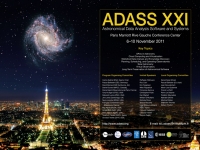Robert Hanisch (STScI/VAO), members of the VAO Team
Abstract
Astronomy is being transformed by the vast quantities of data, models, and simulations that are becoming available to astronomers at an ever-accelerating rate. The U.S. Virtual Astronomical Observatory (VAO) has been funded to provide an operational facility that is intended to be the U.S. community’s principal resource for discovery and access of data, and to provide science services that use these data. VAO services will be built to respond to the growing size and complexity of astronomy data. The VAO is a member of the International Virtual Observatory Alliance.
Over the course of the past year, the VAO has been developing and releasing for community use five science tools, which will be described in detail in other presentations:
1. A Spectral Energy Distribution (SED) tool, Iris, which is a desktop tool to gather data from the NASA Extragalactic Database (NED), augment those data with locally held data, construct spectral energy distributions, and fit those with various emission and absorption models. It uses the STScI-developed Specview tool for visualization of SED’s and the Chandra-developed Sherpa tool for fitting, linked together with the IVOA Simple Applications Messaging Protocol (SAMP).
2. A Data Discovery Tool, which is a web client that allows astronomers to identify and retrieve catalog, image, and spectral data on sources of interest. It offers fast discovery in large data collections.
3. A Scalable Cross-Comparison Facility, which is a web service that allows astronomers to conduct pair-wise positional cross-comparisons between very large catalogs stored remotely as well as between remote and local catalogs. This service supports catalogs with 1 billion records or more.
4. A Time Series Astronomy Tool, which is a web service that allows astronomers to compute periodograms of the public data held at the NASA Star and Exoplanet Database (NStED) and the Harvard Time Series Center. These data include those released from the Kepler and COROT missions, which provide high time resolution and high cadence observations of large numbers of stars, and those released by ground-based transit surveys.
5. A VO-aware release of the Image Reduction and Analysis Facility—IRAF—that provides transparent access to VO-available data collections and is SAMP-enabled, so that IRAF users can easily use tools such as Aladin and Topcat in conjunction with IRAF tasks.
The U.S. VAO has established scientific collaborations with a team conducting a multi-wavelength synthesis of data from the Small Magellanic Cloud and with the HST CANDELS Treasury team, which aims to track the evolution of galaxies and black holes from redshifts of 1.5 to 8.
This talk will provide a summary of this work and an overview of the future directions of the U.S. VAO.
The VAO is operated for the National Science Foundation (NSF) and the National Aeronautics and Space Administration (NASA) by the Virtual Astronomical Observatory Limited Liability Company (VAO, LLC), a non-profit business entity established by the Association of Universities for Research in Astronomy (AURA, Inc.) and the Associated Universities, Inc. (AUI).Slides in PDF format
Paper ID: O18
|

